TSgt. Edward H. Kaczmarek
Buffalo, NY
Depew, NY
Radio Operator
B-24 Liberator
B-24H Serial #42-52151 'Old Tub'
B-24H Serial #41-29229 'Ozark Upstart'/'Old Tub II'
726th Bombardment Squadron(H)
451st Bombardment Group(H)
Fifteenth Air Force
Mediterranean Theater of Operations
Edward H. Kaczmarek was born on June 9th, 1921. I have little info about his life before the
war, but he attended Seneca Vocational High School, studied machining, participated in a few
of the athletics programs, including football, basketball, and track, and graduated in 1939.
Ed's senior entry from the 30th Anniversary edition of 'The Chieftan'.
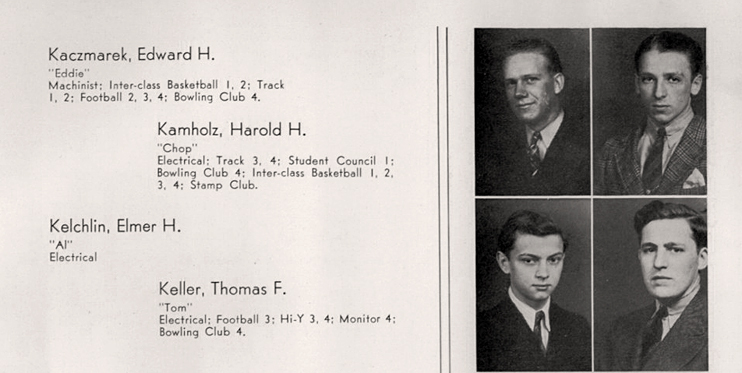
Original Image: The Chieftan 1939 via Classmates -
Larger Image
Here's a look at the machine shop at Seneca...
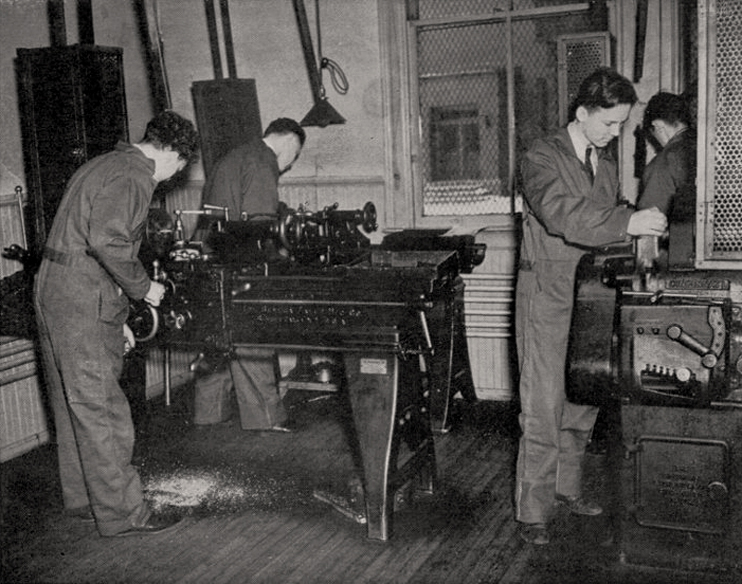
Original Image: The Chieftan 1939 via Classmates -
Larger Image
The football team at Seneca. Ed is #65, seated third from the left.
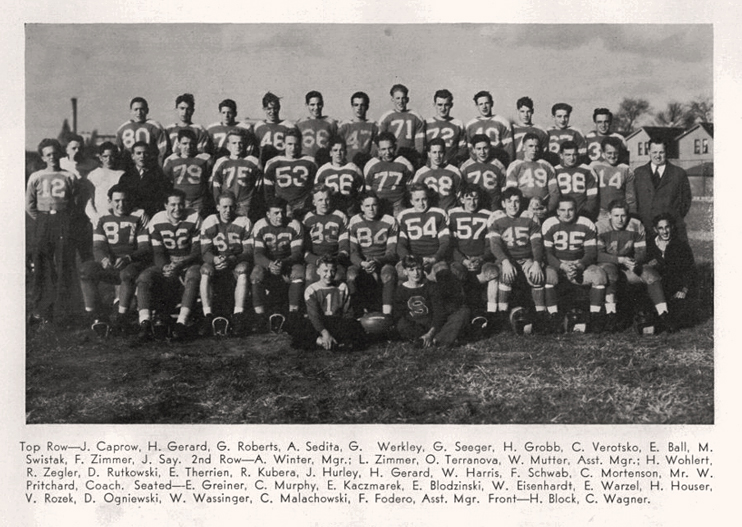
Original Image: The Chieftan 1939 via Classmates -
Larger Image
Again, I've little info about Ed before the war, and have not been able to find the date of his
enlistment in the Army or where he went for basic training. But he would have gone to the
Radio Operator Mechanic School at Scott Field, Illinois to train as a radio operator. The course
ran five to six months, depending on the number of students and availability of equipment.
Trainees at Scott Field march past a typical morale-booster that you would have
found at nearly every United States military installation during the war.
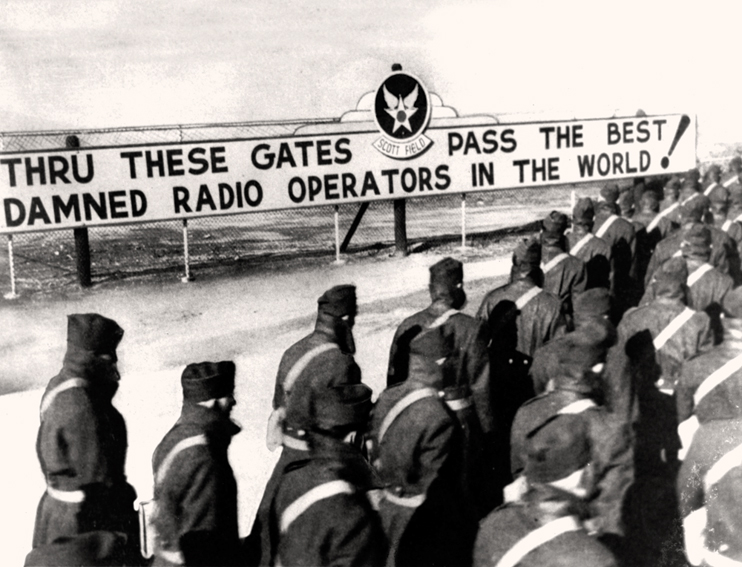
Scott.AF.mil -
Larger Image
Note: the first three of the following four photos were not taken at Scott, but at Tyndall Field, Florida.
They are, however, representative of some of that which a student at Scott's radio school would have experienced.
Students at the radio school would have learned not only how to operate a radio...
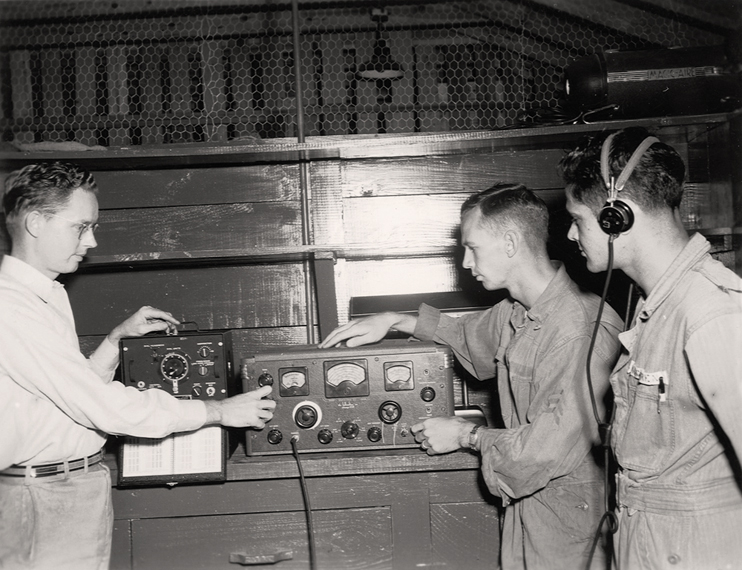
Posted by 'Richard' on Flickr -
Larger Image
...but they would also have learned about what made those magic boxes tick.
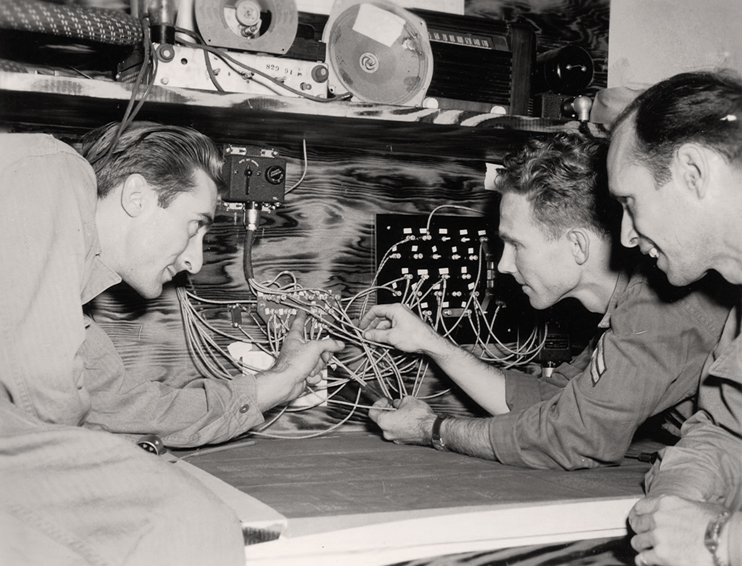
Posted by 'Richard' on Flickr -
Larger Image
Learning morse code...
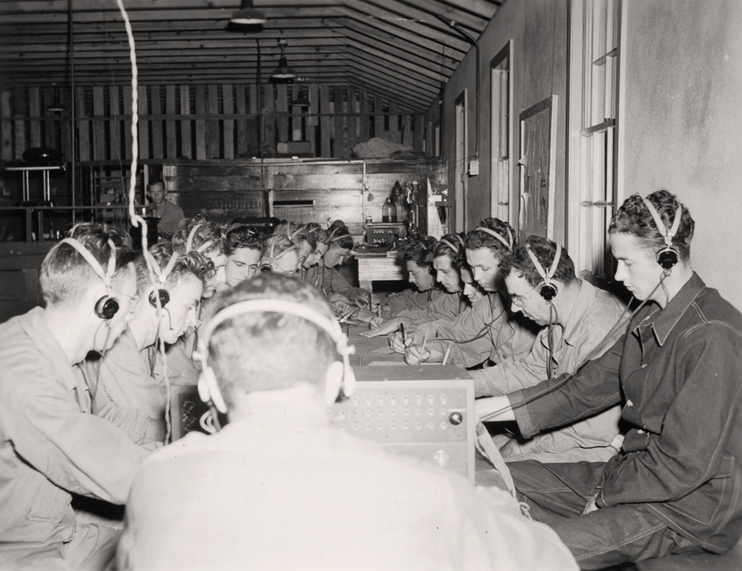
Posted by 'Richard' on Flickr -
Larger Image
And, of course, there were endless hours of classroom instruction.
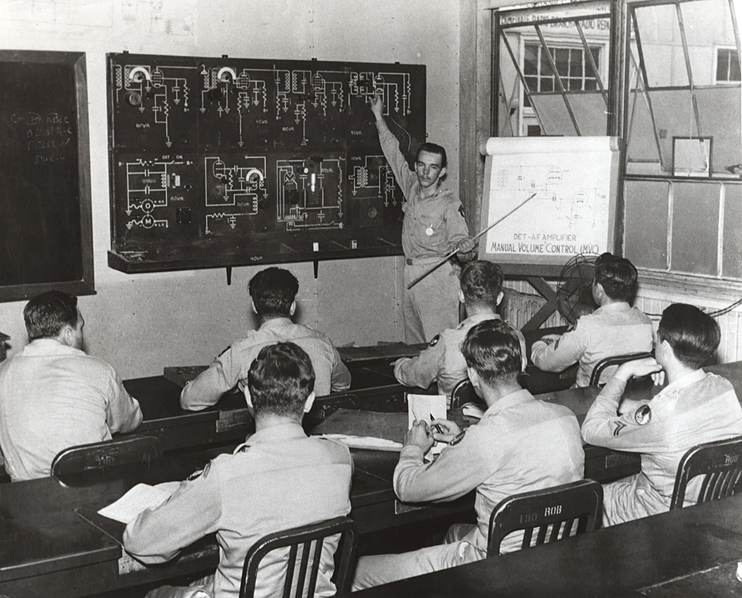
Scott.AF.mil -
Larger Image
From Scott, Ed would have gone to one of the USAAF gunnery schools, though I don't know which.
After that he was asssigned to the 726th Bombardment Squadron (Heavy) of the 451st Bombardment
Group (Heavy) for combat crew transition training, where he met his crewmates for the first time.
The 451st had been activated in April of 1943 and was headquartered at Davis-Monthan Army Air
Field In Tucson, Arizona. However, the group would not spend much time there, moving first to
Dyersburg Army Air Base, Tennessee in June, then to Wendover Field, Utah in July, with the
initial cadre of the air echelon (the group had just four B-24s on strength at the time) attending
the AAFSAT (Army Air Forces School of Applied Tactics) at Orlando Army Air Base, Florida in
June before moving on to Wendover in July. There, the lessons learned at Orlando would be
passed on to the rest of the outfit's aircrews during group-level operational training.
I'm not sure when or where along the way Ed actually joined the 451st, but he would certainly
have been with the outfit by the time operational training had begun at Wendover.
A couple'a photos taken at Wendover Field, albeit several months after the 451st had departed.
Inside the control tower. This view gives you some clue as to why Wendover Field was
referred to by some as 'Leftover Field'. Look out beyond the ramp and runways. Not much
there. Wendover was about as in the middle of nowhere as the middle of nowhere could be.
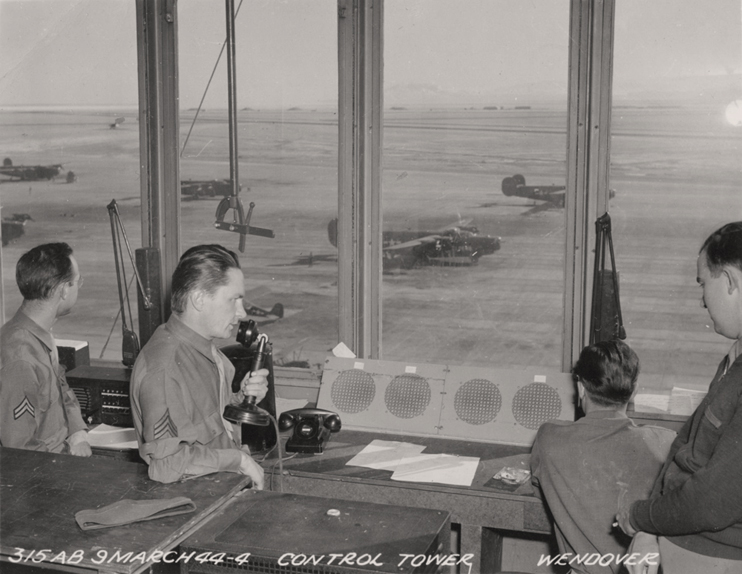
Posted by 'WendoverTom' on the WW2Aircraft Forums -
Larger Image
Engine maintenance on a B-24. For every hour a ship spent in the air, she spent many
more on the ground receiving the TLC necessary to keep her airworthy.
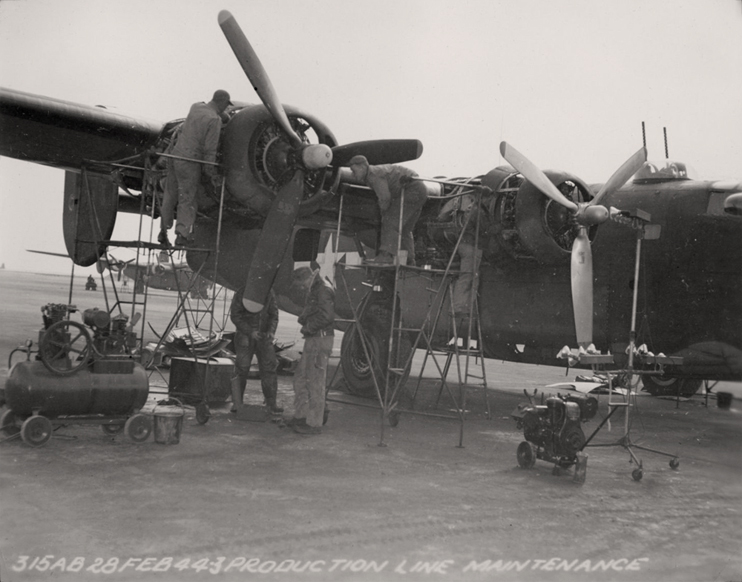
Posted by 'WendoverTom' on the WW2Aircraft Forums -
Larger Image
This photo of Ed at a movie theater was taken in 1943, though I don't know exactly when
or where. It was no earlier than mid to late January, though, as that's when 'The Powers
Girl' (given top billing above the ticket window) was released. Regardless, in less than a
year's time Ed would complete his training and head overseas to Italy, and into combat.
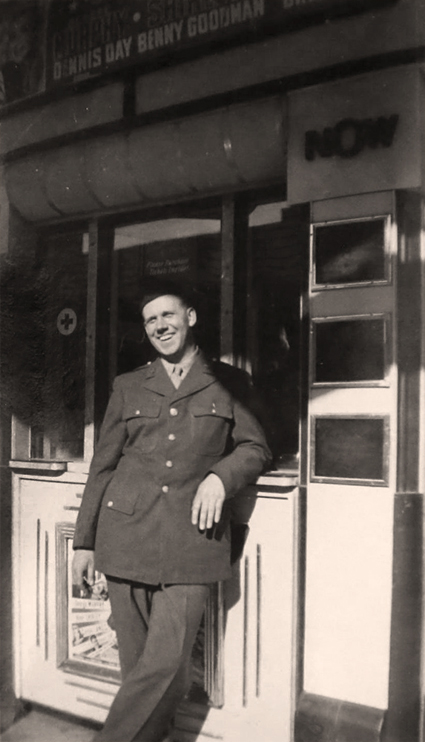
Edward Kaczmarek via The Buffalo News -
Larger Image
In September the 451st moved to Fairmont Army Air Field in Nebraska for the final stages of
training before heading overseas. In mid-November the group would move to Lincoln Army Air
Base, Nebraska, a staging point for the air echelons of bomber groups that were about to head
overseas and into a combat theater. Final logistics were taken care of, the men received inoc-
lations, and last-minute modifications and/or repairs, if required, were made to the aircraft.
This page from a 451st Bombardment Group loading list, dated November 17th, 1943, shows that Ed
was part of crew #52, assigned to fly B-24H serial #42-52151 as part of Flight V of the 451st Air Echelon
from Fairmont Army Air Field, Nebraska to Lincoln Army Air Base, Nebraska for staging preparatory
to the group's move overseas. The flight from Fairmont to Lincoln took place on November 18th, 1943.
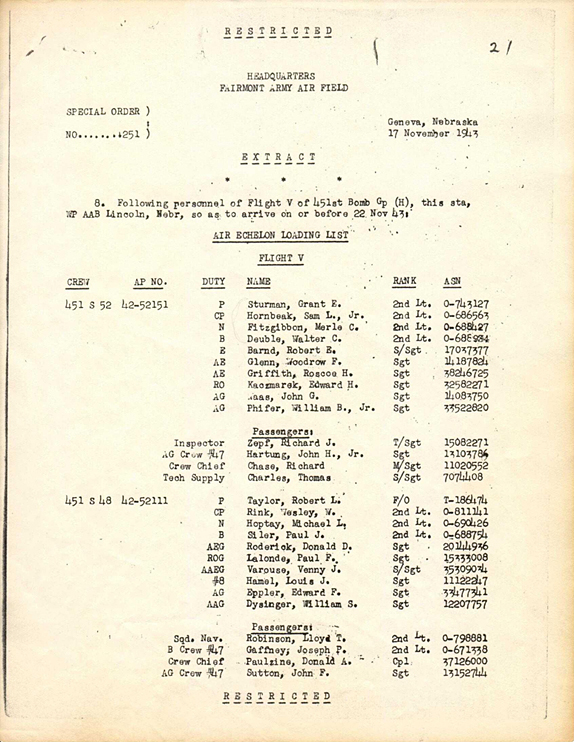
451st.org -
Larger Image
See the full document
HERE, on the 451st.org website, or
HERE, on the WNY Vets site.
A closer look at the crew and passenger list for Ed's ship.
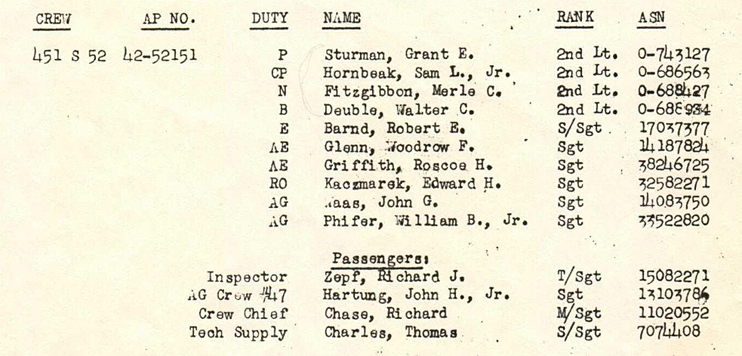
451st.org -
Larger Image
After spending a little less than a month at Lincoln, on December 7th, 1943 Ed and his crew set
out on their journey across the Atlantic. Most of the other ships had already departed, so Ed's gang
were among the last of the 451st Air Echelon to arrive at Telergma, Algeria in mid-December. Once
there, the group underwent a few more weeks of training before moving North to Italy.
By mid-January, construction on the group's first base in Italy had progressed sufficiently
to allow commencement of operations, and so the sixty B-24s of the 451st Bombardment Group left
Telergma on January 20th, arriving at Gioia del Colle, Italy later that day. Though the group was
able to fly one last practice run three days later, Mother Nature saw fit to prevent much more
flying for the remainder of the month and it wasn't until January 30th, 1944 that the
451st Bombardment Group was at last able to fly its first combat mission.
Though crews were assigned their own ships, often times they flew whatever aircraft was available.
That was the case on February 8th, 1944 when, for the group's fourth combat mission, another crew
took the ship that was assigned to Ed's crew, B-24H 42-52151 which they had named 'Old Tub'. Shortly
after takeoff from Northrup Air Base at 8AM the ship stalled and crashed, killing all but two aboard.
See the accident report
HERE,
on the 451st.org website, or
HERE, on WNY Vets.
After the loss of the original 'Old Tub', Ed's crew was assigned the other crew's ship,
B-24H 41-29229, named 'Ozark Upstart'. She was eventually renamed to 'Old Tub' and was
apparently referred to as 'Old Tub II', though I am not sure when the rename took place.
On March 5th the 451st moved to San Pancrazio Airfield, then again on April 6th, to
Castelluccio Airfield where the outfit would remain until the end of the war.
Castelluccio was part of the 'Foggia Airfield Complex', which you can read about
HERE.
An aerial view of Castelluccio Airfield, the final home of the 451st BG in Italy.
The 726th Bombardment Squadron was situated in the upper left corner of the field.
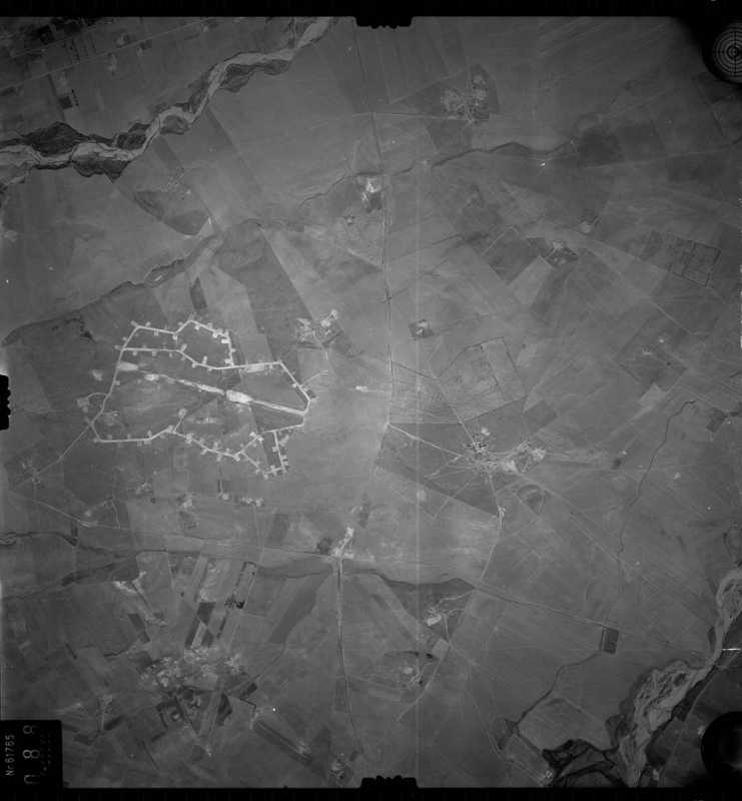
American Air Museum in Britain
This photo, taken during a mission to Ploesti, Romania on May 5th, 1944 is said to show
41-29229 on the right, though I have not confirmed this through my own research. The nose
number does look like it could be '45', though, which was the number carried by both the
original 'Old Tub' and the 'Ozark Upstart' after Ed's crew took her over. There appears
to be a name on the nose, though I have not been able to make out what it is.
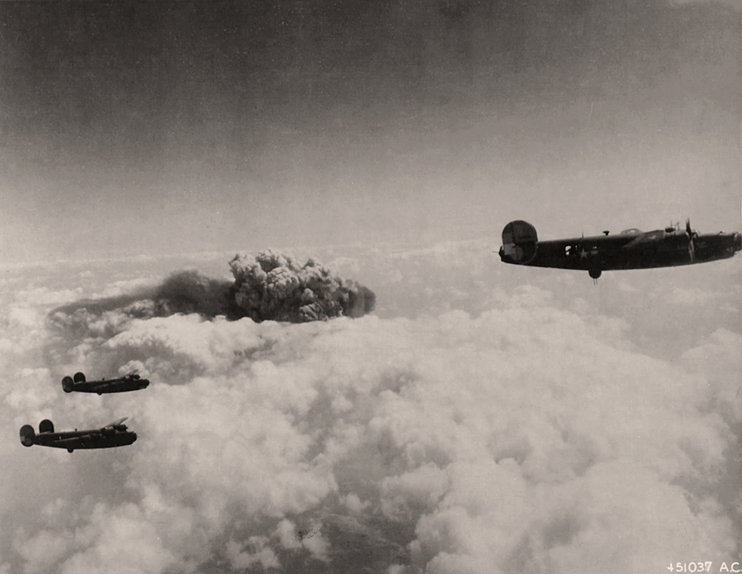
National Archives and Records Administration via Fold3 -
Larger Image
A closer look...
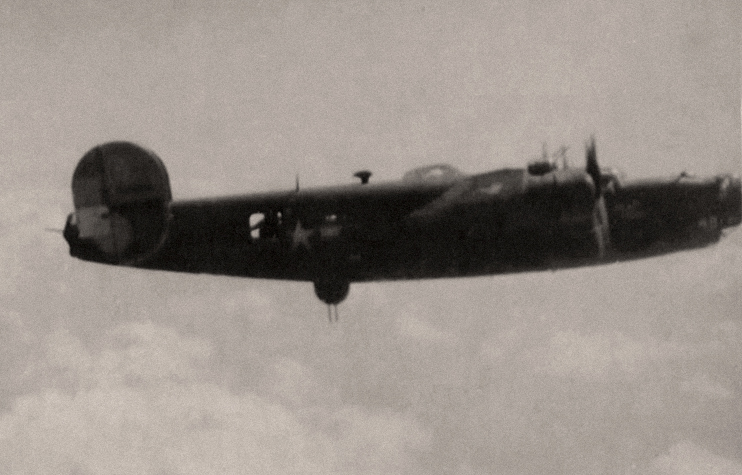
National Archives and Records Administration via Fold3 -
Larger Image
Just a few days before the above photo was taken, on May 1st, it was announced
in the Buffalo Evening News that Ed had been promoted to Technical Sergeant.
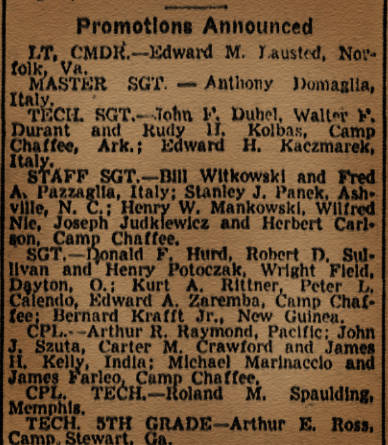
Original Image: Fulton History
May 31st, 1944, the Fifteenth Air Force hits Ploesti again.
The NARA caption for this photo reads:
Waves of Consolidated B-24 Liberators of the 15th AAF fly over the target area, the Concordia Vega
oil refinery, Ploesti, Rumania, unmindful of bursting flak, after dropping their bomb loads on the oil
cracking plant, on 31 May 44, during the strongest heavy bombardment attack of the day. Pillars of black
smoke rise from hits on the storage tank area and oil pumping station, as well as other installations.
Though this photo shows ships of the 451st, and Ed and his crew flew on this mission,
I don't think that Ed's ship is seen here. The ship closest to the camera is B-24G
serial #42-78145, named 'CON JOB', and the ship on the right is B-24H 41-29233,
named 'Sod Buster'. Both were from the 727th Bombardment Squadron.
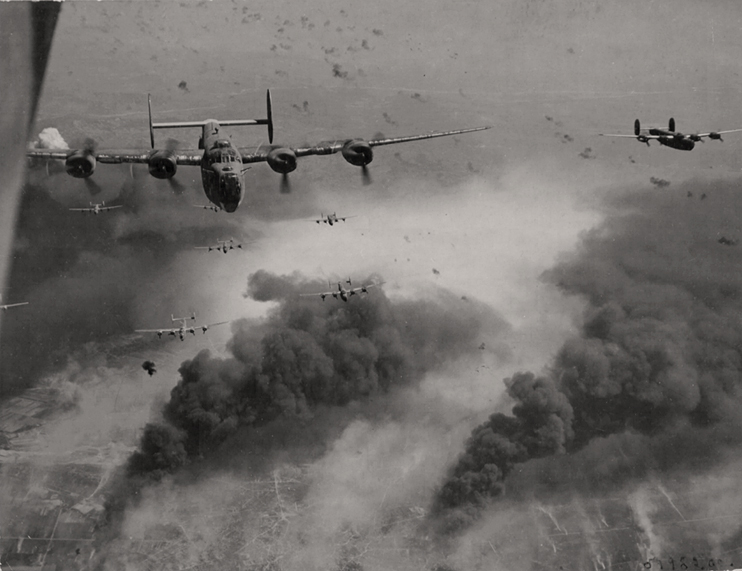
National Archives and Records Administration via Fold3 -
Larger Image
The 'flimsy' for the May 31st mission to Ploesti shows that Ed's ship was in the 1st Flight of the
2nd Attack Unit as denoted by 'S-229-Sturman'. 'CON JOB' is denoted by '804-Reed-Evans'.
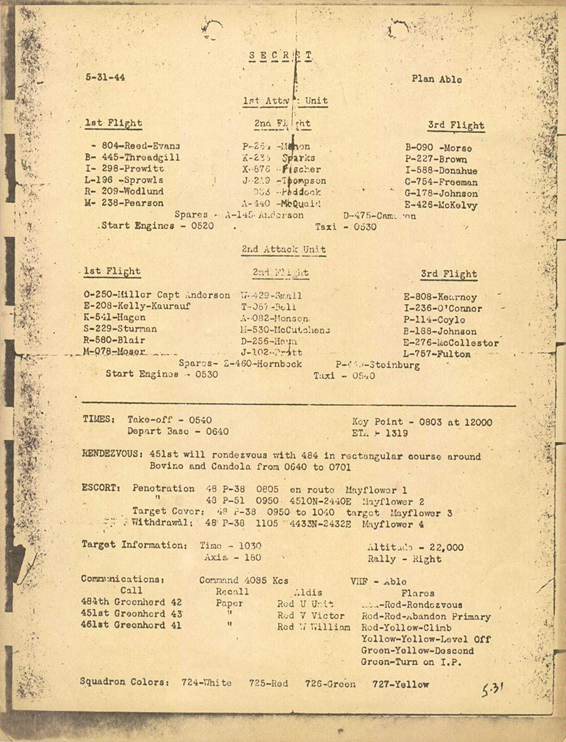
451st.org -
Larger Image
Oh, you probably wanna know what Ed's 'office' in the B-24 looked like, huh?
It seems that in some B-24s the radio op was located in the nose of the aircraft, just
behind the cockpit, while in others he was in the mid-section, above the rear portion of
the bomb bay. I'm not sure which was the case for Ed, but here's a look at the latter.
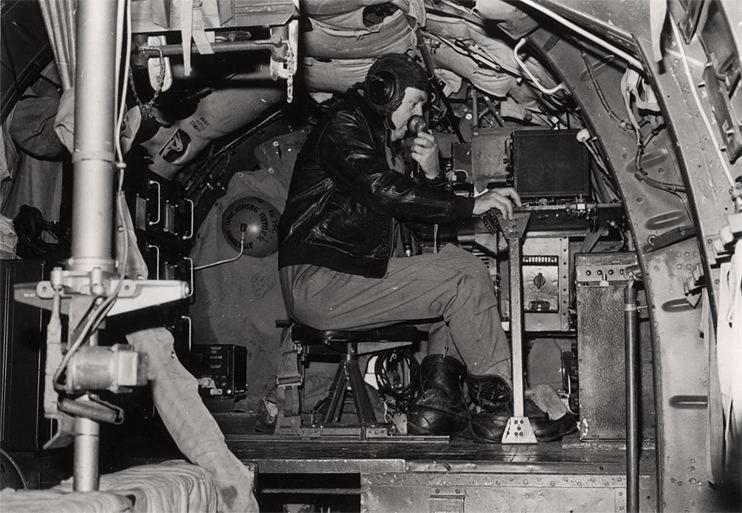
Imperial War Museum (Roger Freeman collection) -
Larger Image
To paraphrase a number of descriptions I've read about the radio op:
The radio operator had the least glamorous job in a B-24. This fellow sat for hours on
end, static crackling in his ears, giving position reports every thirty minutes, assisting the
navigator in taking fixes, and informing headquarters of targets attacked and results. Sending
distress signals was his responsibility. He maintained the equipment in good working order,
maintained a log, preflighted the radio equipment, and often acted as the crew photographer.
He was a trained gunner, manning one of the waist guns, the top turret, or the nose turret,
and filling in for wounded crewmates whenever necessary. Finally, the radio operator
was responsible for first aid equipment he fervently hoped would remain unused.
Glamorous or not, Ed's job was a mighty important one.
Here's Ed, third from left, and part of his crew with the second 'OLD TUB'.
This was the ship that Ed's crew took over from the crew that had gone down in the original
'OLD TUB'. She was B-24H Serial #41-29229, originally name 'Ozark Upstart', and was sent to
Depot 52 on July 13th, 1944 where it's believed she was salvaged. Pretty much all bombers
gradually took a beating over time, with some declared 'war weary'; a simple two-word term
meaning the bird was just plain worn out. That was undoubtedly the case with 'OLD TUB'.
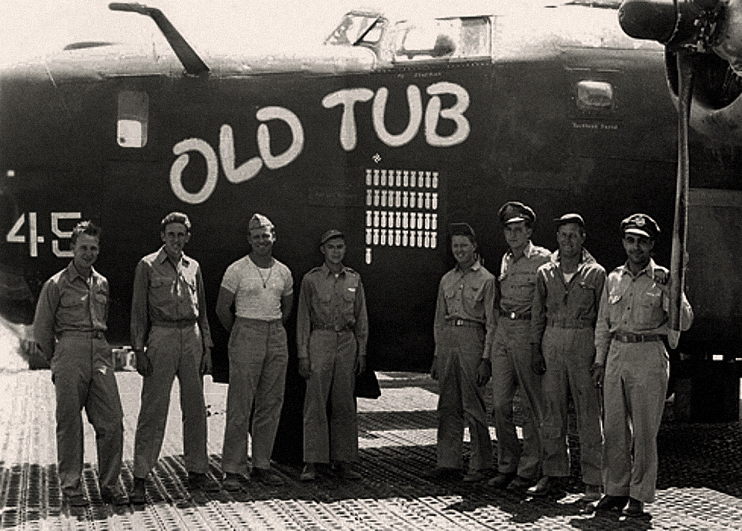
From: B-24 Liberators of the 15th Air Force/49th Bomb Wing in World War II by Michael D. Hill & John R. Beitling
This article from the July 31st, 1944 edition of The Courier Express features
Ed and another boy from Buffalo, both of whom had completed 50 missions.
Though the writer implies that he might be going for another fifty, Ed's days
with the 451st BG were over. At that point in the war, a tour for Fifteenth
Air Force heavy bomber crews was fifty missions. He had done his part.

Original Image: Fulton History
In an interview with the Buffalo News (see that
HERE)
Ed states that his last mission was
to Ploesti, Rumania. A major oil production center, there were no less than nine refineries
located in the vicinity of Ploesti and it was hit by the USAAF many times during the war,
with the 451st BG participating in at least half a dozen strikes during Ed's time with the
outfit. But looking through the extensive mission documentation that's available on the
451st.org website (see
HERE),
the last mention I've found of Ed's crew flying a combat
sortie was in the 'flimsy' for a strike on the Giurgiu Oil Storage facilities at Constanta,
Rumania on June 11th, 1944. The target for that day is confirmed through other sources as
well, including the official USAAF Combat Chronology, so it's possible that Ed's memory of
that day is off. Either way, if June 11th was the date of his last mission, it was an oil target.
Here's the 'flimsy' for the June 11th mission. Ed's ship was in
the 1st Flight of the 2nd Attack Unit, denoted by 'S-229-Sturman'.
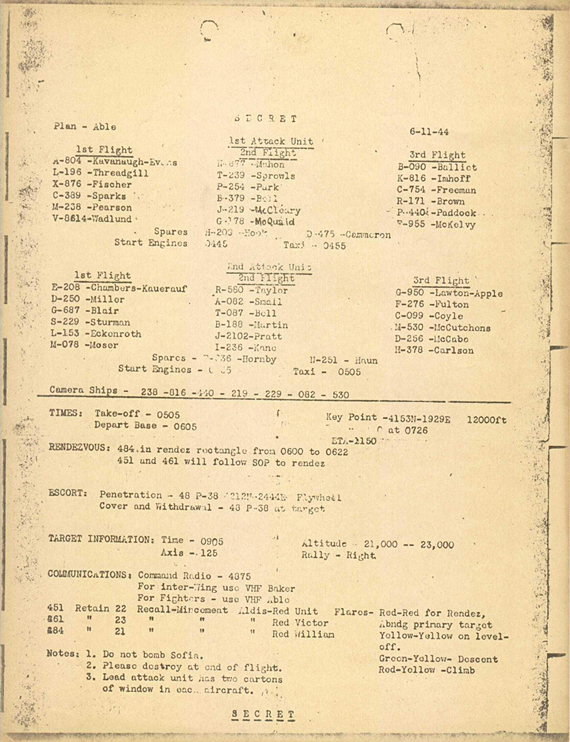
451st.org -
Larger Image
In the Buffalo News interview, Ed mentioned something interesting
which is not often mentioned in connection with USAAF bomber operations:
"crew members dropped shiny strands of material into the air as they approached a target in an
attempt to mislead enemy anti-aircraft gunners into shooting at the diversion instead of the plane"
This was an early form of one of the simplest types of electronic countermeasures known as 'chaff'.
Code-named 'Window', these "shiny strands of material" took on slightly different forms throughout
the war, but they were essentially long, thin strips of aluminum foil, sometimes backed with paper,
that were dropped in bundles by bomber crews during a mission. When properly deployed, each bundle
would quickly disperse and form a large 'cloud' of these aluminum strips that acted as a radar reflector.
Each 'cloud' appeared on German ground-based radar displays as a single contact, so if a bomber had
dropped only one bundle of Window, it would look to the Germans as though there were now two bombers.
But when many bombers dropped many bundles of Window over the course of a given period of time, say,
during the run-up to the target, the radar picture quickly turned into one huge mess. Radar-directed
anti-aircraft guns could no longer operate as effectively as they normally would because the radar
sets used to aim them saw nothing but 'noise' and could not track targets accurately.
Window = Radar 'Jammed'
Though the aircraft is a British Avro Lancaster, this still from a wartime film shows very well
how bundles of Window were deployed by British and American aircraft alike. It's actually
quite fitting that this photos shows a Lanc, as it was the Brits who invented Window.
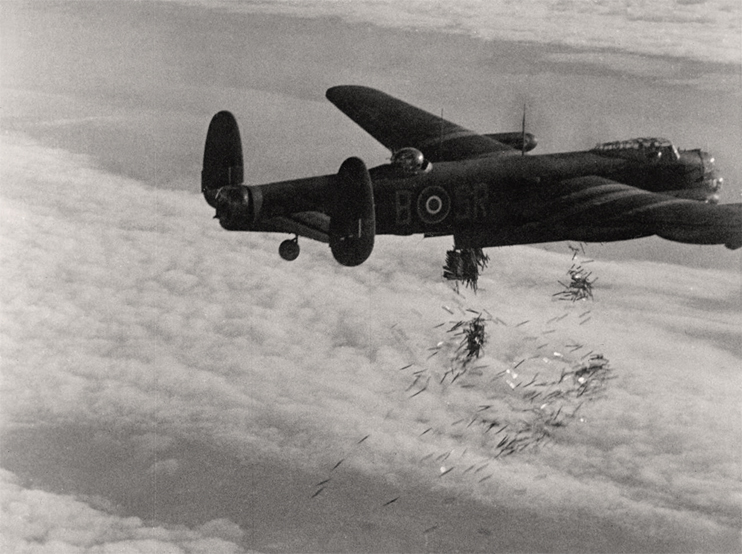
Imperial War Museum (Air Ministry Second World War Official Collection) -
Larger Image
And here's what a cloud of Window looked like...
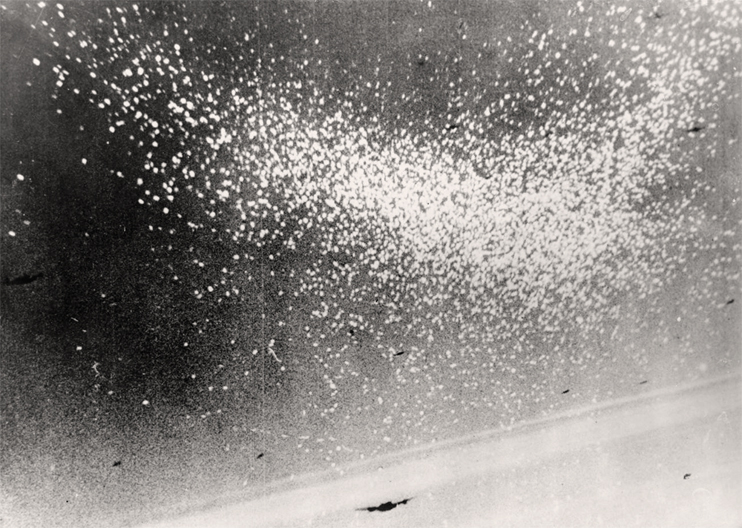
Imperial War Museum (Air Ministry Second World War Official Collection) -
Larger Image
I don't know when Ed returned to the States or have any information regarding his Army service
after finishing his fifty missions, but he was discharged from the Army at Camp Atterbury,
Indiana in November of 1945, as noted in the November 13th edition of the Courier Express:
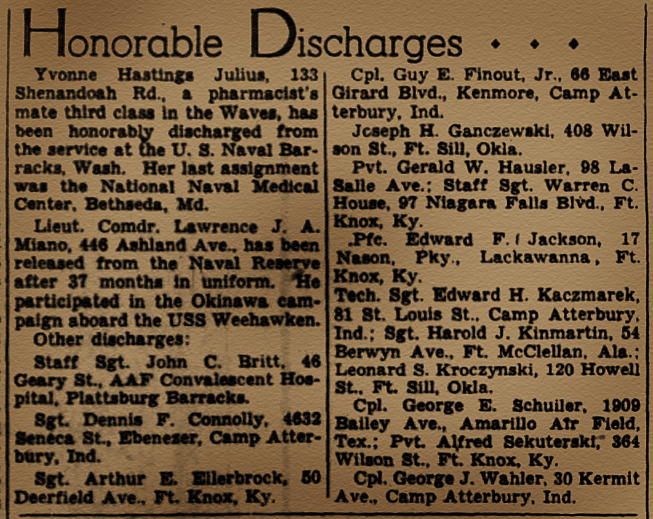
Original Image: Fulton History
After returning home, Ed put his vocational education to good use and worked as a machinist.
He married his sweetheart, Jessica Zasowski, in 1947 and they raised two daughters.
He retired from Trico and, as of this writing (June 2020) is living in Depew, NY.
For more on the 451st Bombardment Group:
451st Bombardment Group (H)
451st Bomb Group - American Air Museum in Britain
Back to 'WNY Vets - USAAF'










